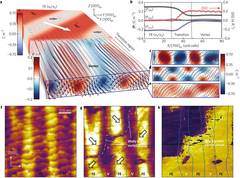Phase coexistence and electric-field control of toroidal order in oxide superlattices
| Reviews and Highlights | Quantum Science | Molecular and Soft-matter | Ultrafast Nano-optics and Nanophotonics | Mineralogy and Geochemistry |
|---|
Anoop R. Damodaran, James D. Clarkson, Zijian Hong, Huiyun Liu, Ajay K. Yadav, C. T. Nelson, Shang-Lin Hsu, Margaret R. McCarter, Kyoung-Duck Park, Vasily Kravtsov, Alan Farhan, Yonki Dong, Zonghou Cai, Pablo Aguado-Puente, Francisco P. García-Fernández, Jorge Íñiguez, Javier Junquera, Andreas Scholl, Markus B. Raschke, Long-Qin Chen, Dillon D. Fong, Ramamoorthy Ramesh, and Lane W. Martin
Nature Materials 16, 1003 (2017).
DOI PDF SI

Systems that exhibit phase competition, order parameter coexistence, and emergent order parameter topologies constitute a major part of modern condensed-matter physics. Here, by applying a range of characterization techniques, and simulations, we observe that in PbTiO3/SrTiO3 superlattices all of these effects can be found. By exploring superlattice period-, temperature- and field-dependent evolution of these structures, we observe several new features. First, it is possible to engineer phase coexistence mediated by a first-order phase transition between an emergent, low-temperature vortex phase with electric toroidal order and a high-temperature ferroelectric a1/a2 phase. At room temperature, the coexisting vortex and ferroelectric phases form a mesoscale, fibre-textured hierarchical superstructure. The vortex phase possesses an axial polarization, set by the net polarization of the surrounding ferroelectric domains, such that it possesses a multi-order-parameter state and belongs to a class of gyrotropic electrotoroidal compounds. Finally, application of electric fields to this mixed-phase system permits interconversion between the vortex and the ferroelectric phases concomitant with order-of-magnitude changes in piezoelectric and nonlinear optical responses. Our findings suggest new cross-coupled functionalities.
